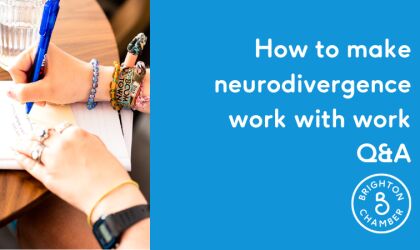

As part of Mental Health Awareness week Amy Lishman, Head of Member Engagement and Deputy CEO at Brighton Chamber, talks with Anna Golawski of Stratus Coaching Ltd about anxiety in the workplace and how you can manage it.
You can find the accompanying handout here.
What is anxiety and how does it differ to stress and burnout?
Anxiety is something that everyone experiences, it’s a normal part of being human. From an evolutionary perspective it’s there as a survival instinct, to keep us safe by perceiving danger. Even in the modern world, everyone is going to feel anxious from time to time – it can be caused by things like exams, presentations, deadlines, and public speaking.
Recent research into anxiety shows that 60% of the population experience mild to moderate anxiety, and 25% experience anxiety at a level where it stops them from doing things. So, feeling anxious is not uncommon. The point where it tips over into becoming an anxiety disorder is when the emotional response is out of proportion to the event, and it becomes overwhelming to the point where it stops you from being able to function.
Often, people use the terms anxiety and stress interchangeably. While they can and do coexist, and the signs and symptoms overlap, it can be useful to know the difference. Stress is defined as a response to a specific event – whether real or perceived danger. Anxiety is a lot more generalised existing outside of a given situation. Anxiety itself is an umbrella term for a number of more specific disorders, including panic disorders, phobias, acute stress disorder, PTSD, OCD and generalised anxiety.
Burnout is a common consequence of long periods of stress and anxiety, which leave you feeling depleted and drained, with little energy or enthusiasm.
Are there specific triggers or situations which tend to make anxiety worse?
This varies from person to person, but anxiety can be triggered by events in someone’s personal life including breakups, physical health conditions, side effects from medication, recreational drugs, alcohol, and financial difficulties. In fact, the Samaritans recently revealed that 1 in 5 calls they receive currently revolve around financial pressures.
It can also be affected by stressful situations at work like deadlines, client meetings, and lack of resources.
What are the common signs and symptoms of anxiety and how do they manifest at work?
In the same way that anxiety can be caused by different things for different people, it also manifests in different ways. Some common physical effects are shallow breathing, increased heart rate, hot flushes, trembling, and dry mouth. However, it isn’t always visible – it can also have cognitive and emotional symptoms such as racing thoughts, becoming over-worried or risk averse, difficulty sleeping, negative thinking cycles and difficulty thinking logically.
In the workplace, the main thing you’re looking out for is a variation from someone’s normal behaviour. This could be avoiding meetings, not contributing as much as they usually do, seeming distracted or less willing to socialise – or even asking for more reassurance, support, validation, and feedback.
What strategies are helpful in managing anxiety?
From a scientific perspective, when you’re feeling anxious it’s because your amygdala (the emotional part of your brain) is sending a stress response to your prefrontal cortex (the rational part of your brain). To start reducing anxiety, you need to focus on calming the emotional response to give control back to the rational part of your brain. Find some strategies that work for you, but some suggestions are:
- Physical exercise (to promote serotonin and reduce adrenaline)
- Relaxing activities like reading
- Spending time in nature
- Breathing exercises
- Mindfulness practice
- Talking it through with someone
These are all good habits to get into before things become overwhelming – an ounce of prevention is worth a pound of cure.
How can leaders and managers support anxious employees at work?
As a manager, the key thing you can do is communicate with your employees and create the space for them to be able to express their feelings. Ask lots of
open questions to try and understand the underlying causes and the impact without being judgemental – not everything that makes us feel anxious in the workplace is caused by a workplace situation. You might not be able to provide a solution, but you can make sure they feel heard and supported.
Having regular check-ins with your employees can be good, but it needs to be embedded in the culture of the organisation – and done with genuine good intentions. Anything you can do to normalise the conversation around mental health is a great step.
In terms of practical things you can do, a good way of encouraging mental breaks is to shorten meetings (25 minutes instead of 30, or 50 instead of an hour). You can also encourage employees to access assistance programs and other forms of support available. Speaking to a GP is a good place to start, and there are also specific support organisations for different issues that people might have.
Companies have a duty of care to look after their employees. The Health and Safety at Work Act includes psychological stress and unnecessary pressures. Leaders should all go through appropriate training to be able to support their employees, and the consideration for mental health needs to be modelled from the top down.
There is often a perception that leaders or managers can’t show their own anxiety because they need to be calm and in control – but it’s ok to show some vulnerability (while maintaining appropriate boundaries!)
What should you look for when choosing a professional to help address your stress or anxiety?
The first thing to do is make sure you’re accessing the right kind of support. Counselling is more effective for long-term issues rooted in past experience, while coaching can be useful for developing solid coping strategies and is more forward-focused.
You should look for qualifications, particularly when it comes to coaches. Counselling has strict regulations around training and certification, but coaching doesn’t – so look at their experience, credibility and references. It’s best practice to always have an introductory session with a professional to make sure it’s a good fit and that you feel comfortable.
Remember, you don’t have to have all the answers. Communication can be difficult, but care and compassion go a long way.
Anna Golawski is Owner and Founder of Stratus Coaching, helping businesses and their employees to better manage stress and performance in the workplace.
Find more Chamber Q&As on topics from strategy and marketing, HR and wellbeing to our YouTube channel, and find upcoming learning and topical events on our events calendar.
If you want to contribute to the Chamber blog, contact us on hannah@brightonchamber.co.uk



